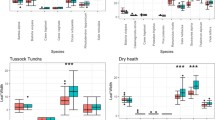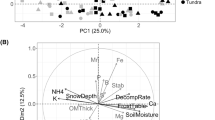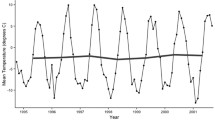Abstract
Tundra vegetation is responding rapidly to on-going climate warming. The changes in plant abundance and chemistry might have cascading effects on tundra food webs, but an integrated understanding of how the responses vary between habitats and across environmental gradients is lacking. We assessed responses in plant abundance and plant chemistry to warmer climate, both at species and community levels, in two different habitats. We used a long-term and multisite warming (OTC) experiment in the Scandinavian forest–tundra ecotone to investigate (i) changes in plant community composition and (ii) responses in foliar nitrogen, phosphorus, and carbon-based secondary compound concentrations in two dominant evergreen dwarf-shrubs (Empetrum hermaphroditum and Vaccinium vitis-idaea) and two deciduous shrubs (Vaccinium myrtillus and Betula nana). We found that initial plant community composition, and the functional traits of these plants, will determine the responsiveness of the community composition, and thus community traits, to experimental warming. Although changes in plant chemistry within species were minor, alterations in plant community composition drive changes in community-level nutrient concentrations. In view of projected climate change, our results suggest that plant abundance will increase in the future, but nutrient concentrations in the tundra field layer vegetation will decrease. These effects are large enough to have knock-on consequences for major ecosystem processes like herbivory and nutrient cycling. The reduced food quality could lead to weaker trophic cascades and weaker top down control of plant community biomass and composition in the future. However, the opposite effects in forest indicate that these changes might be obscured by advancing treeline forests.





Similar content being viewed by others
References
Aerts R, Callaghan TV, Dorrepaal E, van Logtestijn RSP, Cornelissen JHC. 2009. Seasonal climate manipulations result in species-specific changes in leaf nutrient levels and isotopic composition in a sub-arctic bog. Funct Ecol 23:680–8.
Arft A, Walker M, Gurevitch J, Alatalo J, Bret-Harte M, Dale M, Diemer M, Gugerli F, Henry G, Jones M et al. 1999. Responses of tundra plants to experimental warming: meta-analysis of the international tundra experiment. Ecol Monogr 69:491–511.
Aune S, Hofgaard A, Söderström L. 2011. Contrasting climate- and land-use-driven tree encroachment patterns of subarctic tundra in northern Norway and the Kola Peninsula. Can J For Res (Revue Canadienne De Recherche Forestiere) 41:437–49.
Batzli GO, Lesieutre C. 1991. The influence of high quality food on habitat use by arctic microtine rodents. Oikos 72:299–306.
Bhatt US, Walker DA, Raynolds MK, Comiso JC, Epstein HE, Jia G, Gens R, Pinzon JE, Tucker CJ, Tweedie CE, Webber PJ. 2010. Circumpolar Arctic tundra vegetation change is linked to sea ice decline. Earth Interact 14:1–20.
Blok D, Schaepman-Strub G, Bartholomeus H, Heijmans MMPD, Maximov TC, Berendse F. 2011. The response of Arctic vegetation to the summer climate: relation between shrub cover, NDVI, surface albedo and temperature. Environ Res Lett 6:035502.
Bokhorst S, Bjerke JW, Street LE, Callaghan TV, Phoenix GK. 2011a. Impacts of multiple extreme winter warming events on sub-Arctic heathland: phenology, reproduction, growth, and CO(2) flux responses. Glob Change Biol 17:2817–30.
Bokhorst S, Huiskes A, Convey P, Sinclair BJ, Lebouvier M, Van de Vijver B, Wall DH. 2011b. Microclimate impacts of passive warming methods in Antarctica: implications for climate change studies. Polar Biol 34:1421–35.
Bret-Harte M, Shaver G, Zoerner J, Johnstone J, Wagner J, Chavez A, Gunkelman R, Lippert S, Laundre J. 2001. Developmental plasticity allows Betula nana to dominate tundra subjected to an altered environment. Ecology 82:18–32.
Broadhurst RB, Jones WT. 1978. Analysis of condensed tannins using acidified vanillin. J Sci Food Agric 29:788–94.
Bryant JP, Kuropat PJ. 1980. Selection of winter forage by subarctic browsing vertebrates: the role of plant chemistry. Annu Rev Ecol Syst 11:261–85.
Cebrian J, Shurin JB, Borer ET, Cardinale BJ, Ngai JT, Smith MD, Fagan WF. 2009. Producer nutritional quality controls ecosystem trophic structure. PLoS One 4:e4929.
Coley PD, Bryant JP, Chapin FS. 1985. Resource availability and plant antiherbivore defense. Science 230:895–9.
Cornelissen JHC, Quested HM, Gwynn-Jones D, Van Logtestijn RSP, De Beus MAH, Kondratchuk A, Callaghan TV, Aerts R. 2004. Leaf digestibility and litter decomposability are related in a wide range of subarctic plant species and types. Funct Ecol 18:779–86.
Cornelissen JHC, Van Bodegom PM, Aerts R, Callaghan TV, Van Logtestijn RSP, Alatalo J, Stuart Chapin F, Gerdol R, Gudmundsson J, Gwynn-Jones D et al. 2007. Global negative vegetation feedback to climate warming responses of leaf litter decomposition rates in cold biomes. Ecol Lett 10:619–27.
Dalen L. 2004. Dynamics of mountain birch treelines in the Scandinavian mountain chain, and the effects of warming. Trondheim, Norway: NTNU.
Dalen L, Hofgaard A. 2005. Differential regional treeline dynamics in the Scandes Mountains. Arct Antarct Alp Res 37:284–96.
De Boeck HJ, De Groote T, Nijs I. 2012. Leaf temperatures in glasshouses and open-top chambers. New Phytol 194:1155–64.
Dearing MD, Foley WJ, McLean S. 2005. The influence of plant secondary metabolites on the nutritional ecology of herbivorous terrestrial vertebrates. Annu Rev Ecol Evol Syst 36:169–89.
Dormann C, Woodin S. 2002. Climate change in the Arctic: using plant functional types in a meta-analysis of field experiments. Funct Ecol 16:4–17.
Elmendorf SC, Henry GHR, Hollister RD, Bjork RG, Bjorkman AD, Callaghan TV, Collier LS, Cooper EJ, Cornelissen JHC, Day TA, Fosaa AM, Gould WA, Gretarsdottir J, Harte J, Hermanutz L, Hik DS, Hofgaard A, Jarrad F, Jonsdottir IS, Keuper F, Klanderud K, Klein JA, Koh S, Kudo G, Lang SI, Loewen V, May JL, Mercado J, Michelsen A, Molau U, Myers-Smith IH, Oberbauer SF, Pieper S, Post E, Rixen C, Robinson CH, Schmidt NM, Shaver GR, Stenstrom A, Tolvanen A, Totland O, Troxler T, Wahren CH, Webber PJ, Welker JM, Wookey PA. 2012. Global assessment of experimental climate warming on tundra vegetation: heterogeneity over space and time. Ecol Lett 15:164–75.
Elser JJ, Bracken MES, Cleland EE, Gruner DS, Harpole WS, Hillebrand H, Ngai JT, Seabloom EW, Shurin JB, Smith JE. 2007. Global analysis of nitrogen and phosphorus limitation of primary producers in freshwater, marine and terrestrial ecosystems. Ecol Lett 10:1135–42.
Forbes BC, Stammler F, Kumpula T, Meschtyb N, Pajunen A, Kaarlejärvi E. 2009. High resilience in the Yamal-Nenets social-ecological system, West Siberian Arctic, Russia. Proc Natl Acad Sci USA 106:22041–8.
Forbes BC, Fauria MM, Zetterberg P. 2010. Russian Arctic warming and ‘greening’ are closely tracked by tundra shrub willows. Glob Change Biol 16:1542–54.
Gottfried M, Pauli H, Futschik A, Akhalkatsi M, Barancok P, Benito Alonso JL, Coldea G, Dick J, Erschbamer B, Fernandez Calzado MR, Kazakis G, Krajci J, Larsson P, Mallaun M, Michelsen O, Moiseev D, Moiseev P, Molau U, Merzouki A, Nagy L, Nakhutsrishvili G, Pedersen B, Pelino G, Puscas M, Rossi G, Stanisci A, Theurillat J-P, Tomaselli M, Villar L, Vittoz P, Vogiatzakis I, Grabherr G. 2012. Continent-wide response of mountain vegetation to climate change. Nat Clim Chang 2:111–15.
Graglia E, Julkunen-Tiitto R, Shaver GR, Schmidt IK, Jonasson S, Michelsen A. 2001. Environmental control and intersite variations of phenolics in Betula nana in tundra ecosystems. New Phytol 151:227–36.
Hansen AH, Jonasson S, Michelsen A, Julkunen-Tiitto R. 2005. Long-term experimental warming, shading and nutrient addition affect the concentration of phenolic compounds in arctic-alpine deciduous and evergreen dwarf shrubs. Oecologia 147:1–11.
Harsch MA, Hulme PE, McGlone MS, Duncan RP. 2009. Are treelines advancing? A global meta-analysis of treeline response to climate warming. Ecol Lett 12:1040–9.
Havas P. 1971. The water economy of the bilberry (Vaccinium myrtillus) under winter conditions. Rep Kevo Subarct Res Stat 8:41–52.
Hjältén J, Danell K, Ericson L. 2004. Hare and vole browsing preferences during winter. Acta Theriol 49:53–62.
Hofgaard A, Wilmann B. 2002. Plant distribution pattern across the forest–tundra ecotone: the importance of treeline position. Ecoscience 9:375–85.
Hofgaard A, Løkken JO, Dalen L, Hytteborn H. 2010. Comparing warming and grazing effects on birch growth in an alpine environment—a 10-year experiment. Plant Ecol Divers 3:19–27.
Iason G. 2005. The role of plant secondary metabolites in mammalian herbivory: ecological perspectives. Proc Nutr Soc 64:123–31.
Kalela O. 1957. Regulation of reproduction rate in subarctic populations of the vole Clethrionomys rufocanus (Sund.). Ann Acad Sci Fenn A IV Biol 34:1–60.
Kitayama K, Aiba S-I. 2002. Ecosystem structure and productivity of tropical rain forests along altitudinal gradients with contrasting soil phosphorus pools on Mount Kinabalu, Borneo. J Ecol 90:37–51.
Körner C, Bannister P, Mark AF. 1986. Altitudinal variation in stomatal conductance, nitrogen content and leaf anatomy in different plant life forms in New Zealand. Oecologia 69:577–88.
Kumpula J, Norberg H, Nieminen M. 2004. Kesälaidunnuksen vaikutukset poron ravintokasveihin: kesälaitumet ja porojen kunto. Kala-ja riistaraportteja 319:92 pp.
Mårell A, Hofgaard A, Danell K. 2006. Nutrient dynamics of reindeer forage species along snowmelt gradients at different ecological scales. Basic Appl Ecol 7:13–30.
Marion G, Henry G, Freckman D, Johnstone J, Jones G, Jones M, Levesque E, Molau U, Mølgaard P, Parsons A et al. 1997. Open-top designs for manipulating field temperature in high-latitude ecosystems. Glob Change Biol 3:20–32.
Myers-Smith IH, Forbes BC, Wilmking M, Hallinger M, Lantz T, Blok D, Tape KD, Macias-Fauria M, Sass-Klaassen U, Lévesque E, Boudreau S, Ropars P, Hermanutz L, Trant A, Collier LS, Weijers S, Rozema J, Rayback SA, Schmidt NM, Schaepman-Strub G, Wipf S, Rixen C, Ménard CB, Venn S, Goetz S, Andreu-Hayles L, Elmendorf S, Ravolainen V, Welker J, Grogan P, Epstein HE, Hik DS. 2011. Shrub expansion in tundra ecosystems: dynamics, impacts and research priorities. Environ Res Lett 6:045509.
Olofsson J, Oksanen L, Callaghan T, Hulme PE, Oksanen T, Suominen O. 2009. Herbivores inhibit climate-driven shrub expansion on the tundra. Glob Change Biol 15:2681–93.
Post E, Pedersen C. 2008. Opposing plant community responses to warming with and without herbivores. Proc Natl Acad Sci 105:12353–8.
Post E, Forchhammer MC, Bret-Harte MS, Callaghan TV, Christensen TR, Elberling B, Fox AD, Gilg O, Hik DS, Høye TT, Ims RA, Jeppesen E, Klein DR, Madsen J, McGuire AD, Rysgaard S, Schindler DE, Stirling I, Tamstorf MP, Tyler NJC, Van Der Wal R, Welker J, Wookey PA, Schmidt NM, Aastrup P. 2009. Ecological dynamics across the Arctic associated with recent climate change. Science 325:1355–8.
Price ML, Buttler LG. 1977. Rapid visual estimation of and spectrophotometric determination of tannin content of sorghum grain. J Agric Food Chem 25:1268–73.
R Development Core Team. 2011. R: a language and environment for statistical computing. Vienna, Austria: R Foundation for Statistical Computing.
Reich PB, Oleksyn J. 2004. Global patterns of plant leaf N and P in relation to temperature and latitude. Proc Natl Acad Sci USA 101:11001–6.
Rinnan R, Stark S, Tolvanen A. 2009. Responses of vegetation and soil microbial communities to warming and simulated herbivory in a subarctic heath. J Ecol 97:788–800.
Schmitz OJ. 2008. Herbivory from individuals to ecosystems. Annu Rev Ecol Evol Syst 39:133–52.
Sjögersten S, Turner BL, Mahieu N, Condron LM, Wookey PA. 2003. Soil organic matter biochemistry and potential susceptibility to climatic change across the forest–tundra ecotone in the Fennoscandian mountains. Glob Change Biol 9:759–72.
Sjögersten S, Wookey PA. 2005. The role of soil organic matter quality and physical environment for nitrogen mineralization at the forest-tundra ecotone in Fennoscandia. Arct Antarct Alp Res 37:118–26.
Soudzilovskaia NA, Onipchenko VG, Cornelissen JHC, Aerts R. 2007. Effects of fertilisation and irrigation on ‘foliar afterlife’ in alpine tundra. J Veg Sci 18:755–66.
Sterner R, Elser J. 2002. Ecological stoichiometry: the biology of elements from molecules to the biosphere. Princeton: Princeton University Press.
Sundqvist MK, Giesler R, Wardle DA. 2011. Within- and across-species responses of plant traits and litter decomposition to elevation across contrasting vegetation types in subarctic tundra. PLoS One 6:e27056.
Tape K, Sturm M, Racine C. 2006. The evidence for shrub expansion in Northern Alaska and the Pan-Arctic. Glob Change Biol 12:686–702.
Taylor M. 2000. Determination of total phosphorus in soil using simple Kjeldahl digestion. Commun Soil Sci Plant Anal 31:2665–70.
Tømmervik H, Johansen B, Riseth JÅ, Karlsen SR, Solberg B, Høgda KA. 2009. Above ground biomass changes in the mountain birch forests and mountain heaths of Finnmarksvidda, northern Norway, in the period 1957–2006. For Ecol Manage 257:244–57.
Torp M, Witzell J, Baxter R, Olofsson J. 2010. The effect of snow on plant chemistry and invertebrate herbivory: experimental manipulations along a natural snow gradient. Ecosystems 13:741–51.
Van Bogaert R, Haneca K, Hoogesteger J, Jonasson C, De Dapper M. 2011. A century of tree line changes in sub-Arctic Sweden shows local and regional variability and only a minor influence of 20th century climate warming. J Biogeogr 38:907–21.
Wahren C-HA, Walker MD, Bret-Harte MS. 2005. Vegetation responses in Alaskan arctic tundra after 8 years of a summer warming and winter snow manipulation experiment. Glob Change Biol 11:537–52.
Walker MD, Wahren CH, Hollister RD, Henry GHR, Ahlquist LE, Alatalo JM, Bret-Harte MS, Calef MP, Callaghan TV, Carroll AB, Epstein HE, Jónsdóttir IS, Klein JA, Magnússon B, Molau U, Oberbauer SF, Rewa SP, Robinson CH, Shaver GR, Suding KN, Thompson CC, Tolvanen A, Totland Ø, Turner PL, Tweedie CE, Webber PJ, Wookey PA. 2006. Plant community responses to experimental warming across the tundra biome. Proc Natl Acad Sci USA 103:1342–6.
Walker DA, Leibman MO, Epstein HE, Forbes BC, Bhatt US, Raynolds MK, Comiso JC, Gubarkov AA, Khomutov AV, Jia GJ, Kaarlejärvi E, Kaplan JO, Kumpula T, Kuss P, Matyshak G, Moskalenko NG, Orekhov P, Romanovsky VE, Ukraientseva NG, Yu Q. 2009. Spatial and temporal patterns of greenness on the Yamal Peninsula, Russia: interactions of ecological and social factors affecting the Arctic normalized difference vegetation index. Environ Res Lett 4:045004.
Warenberg K, Danell Ö, Gaare E, Nieminen M. 1997. In: Ekendahl B, Bye K, Eds. Porolaidunten kasvillisuus. Bergen: Nordiskt organ för renforskning.
Welker J, Fahnestock J, Sullivan P, Chimner R. 2005. Leaf mineral nutrition of Arctic plants in response to warming and deeper snow in northern Alaska. Oikos 109:167–77.
White RG. 1983. Foraging patterns and their multiplier effects on productivity of northern ungulates. Oikos 40:377–84.
Acknowledgments
The authors thank Suvi Katves and Jonas Gustafsson for their invaluable help in the field. “DART”(Dynamics of the Arctic Treeline) project colleagues are acknowledged for establishing and running the experiment. Kongsvoll Biological Station, Abisko Scientific Research Station, and Joatka Fjellstue provided warm accommodations during the field work periods. The work was founded by the European Commission Framework Programme IV grant ENV4-CT97-0586 to DART project, the Swedish Research Council for Environment, Agricultural Science and Spatial Planning to JO and stipends to EK from the Abisko Scientific Station, Norrbotten, Sweden and G & R Björkman.
Author information
Authors and Affiliations
Corresponding author
Additional information
Author Contributions
EK analyzed the data and wrote the paper with contributions from all coauthors. EK and OK performed the vegetation analyses. EK and JO planned this study and prepared samples for chemical analyses. RB, AH, HH, UM, SS, PW, and JO designed, established, and maintained the field experiment.
Electronic supplementary material
Below is the link to the electronic supplementary material.
Rights and permissions
About this article
Cite this article
Kaarlejärvi, E., Baxter, R., Hofgaard, A. et al. Effects of Warming on Shrub Abundance and Chemistry Drive Ecosystem-Level Changes in a Forest–Tundra Ecotone. Ecosystems 15, 1219–1233 (2012). https://doi.org/10.1007/s10021-012-9580-9
Received:
Accepted:
Published:
Issue Date:
DOI: https://doi.org/10.1007/s10021-012-9580-9




